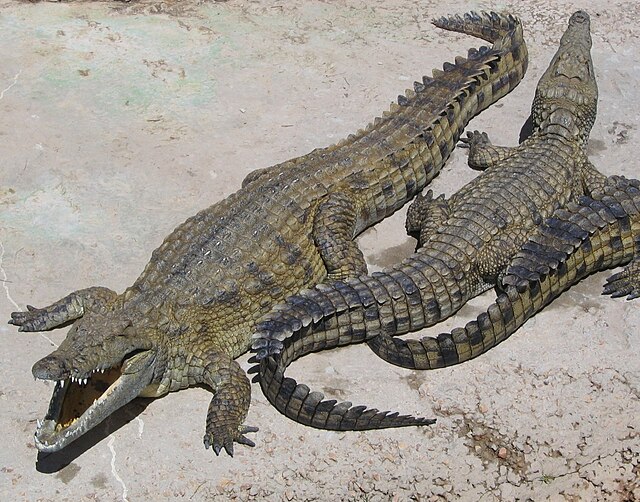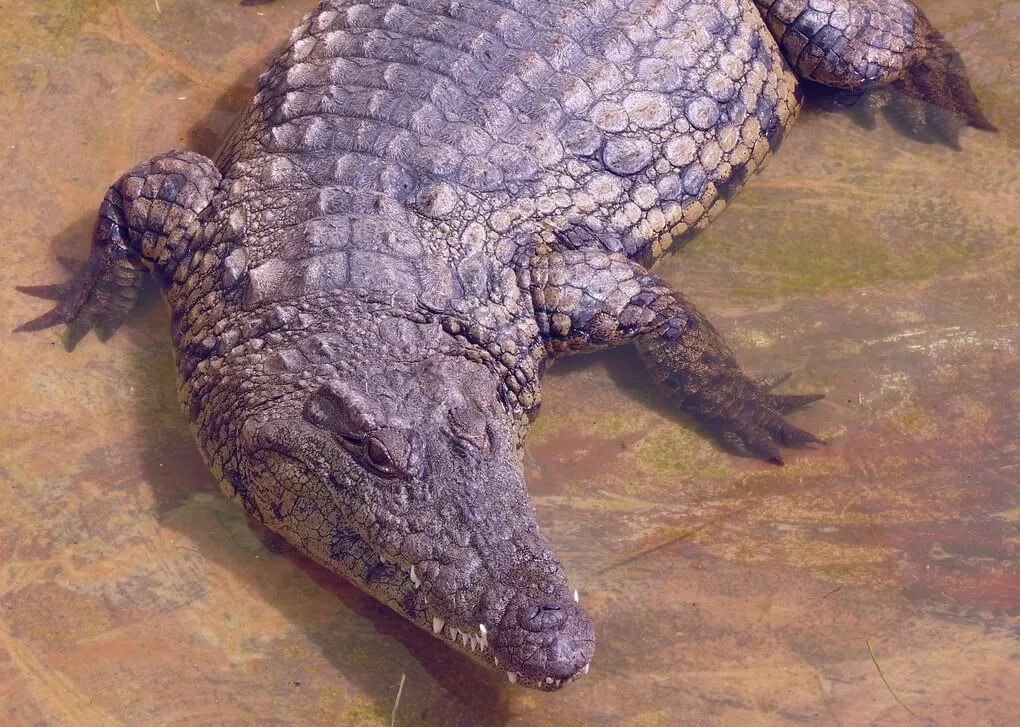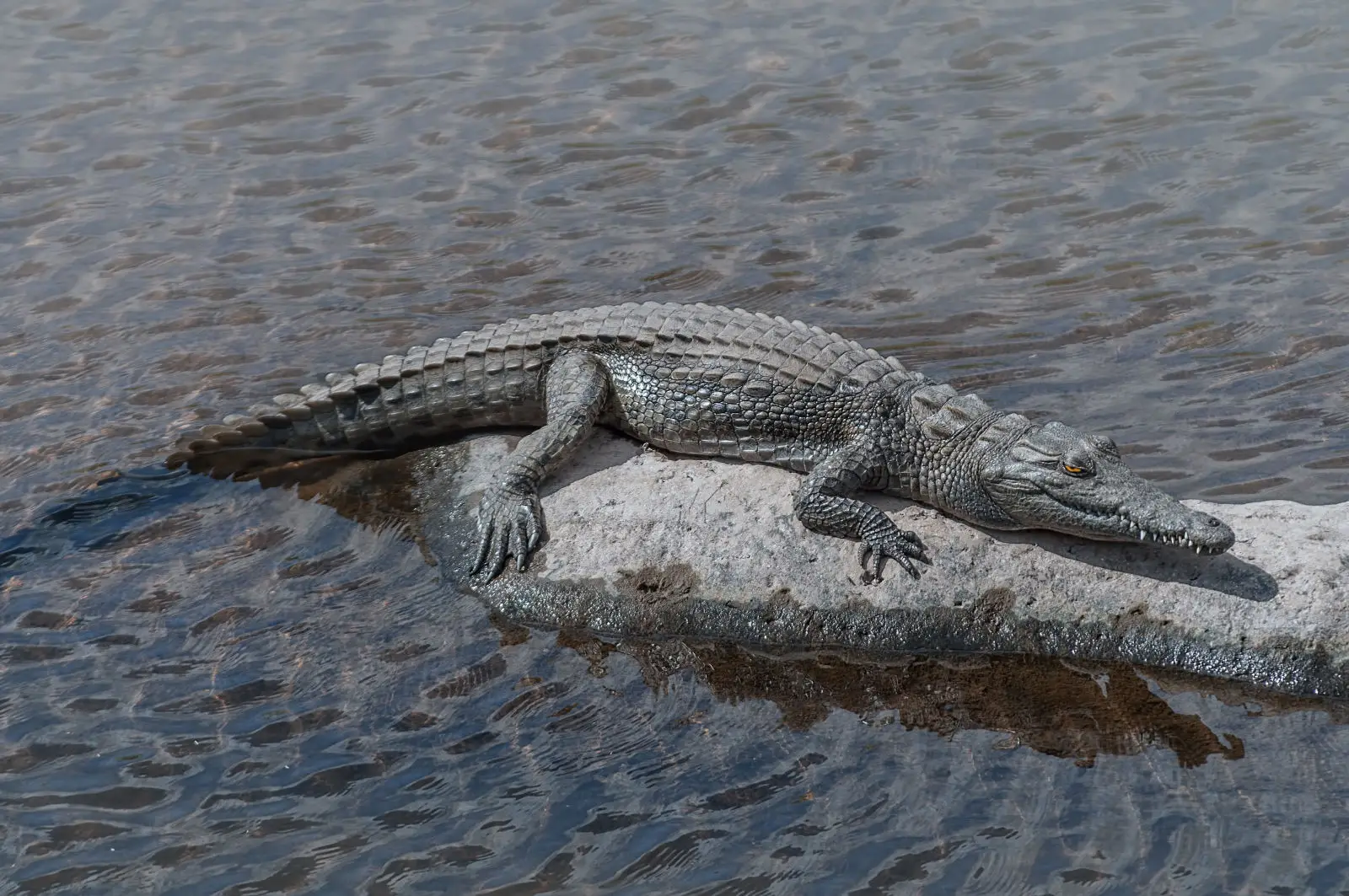Nile Crocodile Swimming Behaviors
Introduction
Nile Crocodile Swimming Behaviors The Nile crocodile (Crocodylus niloticus) is one of the most formidable predators in the animal kingdom, renowned for its powerful build and hunting prowess. Found throughout the freshwater habitats of Africa, these reptiles are fascinating not only for their strength but also for their remarkable swimming behaviors. Understanding these behaviors is crucial for appreciating their role in the ecosystem and for implementing effective conservation strategies. This article explores the swimming techniques, environmental influences, and the impact of human activities on the Nile crocodile’s aquatic behaviors.
Anatomy and Physiology of Swimming

Nile crocodiles are expertly adapted for life in the water. Their streamlined bodies reduce drag, allowing them to move swiftly and efficiently. A key feature of their anatomy is the powerful tail, which acts as a propeller, providing thrust and agility while swimming. Additionally, their webbed feet assist in steering and maneuverability.
Here’s a simple table summarizing key aspects of Nile crocodile swimming behaviors:
| Aspect | Description |
|---|---|
| Species | Nile Crocodile (Crocodylus niloticus) |
| Habitat | Freshwater environments such as rivers, lakes, and swamps across Africa |
| Anatomical Adaptations | – Streamlined body for reduced drag – Powerful tail for propulsion – Webbed feet for steering |
| Swimming Techniques | – Active Swimming: Quick bursts of speed for hunting – Passive Swimming: Drifting to conserve energy |
| Hunting Behavior | Stealthy approaches and ambush techniques, often swimming just below the surface |
| Social Interaction | Group swimming behaviors, territorial displays, and social hierarchy among crocodiles |
| Mating Rituals | Courtship displays involving swimming behaviors to attract mates |
| Environmental Influences | – Water Temperature: Affects metabolism and swimming activity – Habitat Type: River currents vs. still water – Seasonal Changes: Alters competition and hunting strategies |
| Human Impact | – Pollution and habitat destruction threaten populations – Conservation efforts are essential for survival |
This table captures essential information about Nile crocodile swimming behaviors in a concise format. Let me know if you need any modifications or additional details!
One of the unique adaptations of Nile crocodiles is their ability to control buoyancy through air sacs located in their bodies. By regulating the air in these sacs, they can adjust their position in the water column, enabling them to swim at various depths with ease.
Swimming Techniques

Nile crocodiles employ several swimming styles depending on their needs. Active swimming involves quick, powerful movements to chase prey or escape threats, while passive swimming allows them to drift with the current, conserving energy.
When swimming, crocodiles primarily use their tails for propulsion, engaging their legs only for steering. They can swim effectively both at the surface and underwater, holding their breath for extended periods. This versatility allows them to adapt their swimming techniques based on environmental conditions and hunting strategies.
Swimming Behavior in Different Contexts
Swimming behaviors in Nile crocodiles vary greatly based on context:
A. Hunting and Feeding Crocodiles are ambush predators, often using stealth to approach their prey. They can silently swim just below the water’s surface, using only their eyes and nostrils to remain visible. When the moment is right, they launch a rapid attack, showcasing their speed and agility.
B. Social Interactions Nile crocodiles are not solitary creatures; they often swim in groups. This social behavior includes displaying territoriality, where dominant males may assert their presence through aggressive displays or physical confrontations in the water.
C. Mating Rituals During the breeding season, swimming plays a critical role in courtship. Males may perform elaborate displays, such as submerging and surfacing dramatically to attract females. These rituals are essential for reproductive success and maintaining genetic diversity.
V. Environmental Influences on Swimming
Swimming behavior is influenced by various environmental factors:
A. Water Temperature The temperature of the water affects a crocodile’s swimming speed and activity levels. Warmer waters generally increase metabolism, leading to more active swimming.
B. Habitat Different habitats, such as rivers versus lakes, present unique challenges and opportunities for crocodiles. River currents may necessitate stronger swimming abilities, while still waters allow for more leisurely movement.
C. Seasonal Changes Seasonal variations also influence swimming patterns. For instance, during the dry season, water levels drop, leading to increased competition and changes in hunting strategies, which can affect swimming behavior.
Human Interaction and Impact

Human activities pose significant threats to the habitats of Nile crocodiles. Pollution from agricultural runoff and urban development can degrade water quality and reduce prey availability. Additionally, habitat destruction through damming rivers and draining wetlands has led to declining crocodile populations.
Conservation efforts are essential for protecting the aquatic environments that Nile crocodiles rely on. Preserving these habitats not only benefits the crocodiles but also supports the overall health of the ecosystems in which they live.
Conclusion
The swimming behaviors of Nile crocodiles are a testament to their remarkable adaptations and survival strategies. From hunting and social interactions to the effects of environmental changes, these behaviors highlight the complex relationship between crocodiles and their aquatic habitats. Protecting these environments is vital for the survival of Nile crocodiles and the ecosystems they inhabit. As we continue to study and understand these incredible creatures, we must also advocate for their conservation to ensure their presence for future generations.
Tips for Observing Nile Crocodile Swimming Behaviors
Choose the Right Location:
Look for rivers, lakes, or wetlands where Nile crocodiles are known to inhabit. Popular locations include the Nile River, Lake Victoria, and various national parks in Africa.
Visit During Early Morning or Late Afternoon:
Crocodiles are more active during these cooler parts of the day. Early mornings and late afternoons offer the best opportunities to observe swimming behaviors as they hunt or bask in the sun.
Use Binoculars:
Bring binoculars for a closer view without disturbing the crocodiles. This will allow you to observe their swimming techniques and behaviors from a safe distance.
Stay Quiet and Patient:
Crocodiles can be easily startled. Approach quietly and be patient; they may take time to appear if they sense human presence.
Look for Hunting Techniques:
Observe how crocodiles approach their prey while swimming. Notice their stealthy movements, body position, and the use of their tails for propulsion.
Watch for Social Interactions:
If you see multiple crocodiles, watch for social behaviors, such as group swimming or territorial displays. Note how they interact with each other in the water.
Document Observations:
Keep a journal or use a digital app to record your observations of swimming behaviors, environmental conditions, and any interactions you witness.
Here’s a list of frequently asked questions (FAQs) related to Nile crocodile swimming behaviors:
FAQs About Nile Crocodile Swimming Behaviors
How fast can Nile crocodiles swim?
Nile crocodiles can reach speeds of up to 20 km/h (12 mph) in short bursts when swimming. However, they typically move at a more moderate pace while hunting or basking.
Do Nile crocodiles prefer swimming in shallow or deep water?
Nile crocodiles are adaptable and can thrive in both shallow and deep water. They often prefer shallow areas for basking and hunting but will venture into deeper waters when necessary.
How long can Nile crocodiles hold their breath underwater?
Nile crocodiles can hold their breath for up to two hours underwater, although they typically surface for air every 15 to 30 minutes when actively swimming.
Are Nile crocodiles solitary or social swimmers?
While Nile crocodiles are primarily solitary, they can exhibit social behaviors, especially in areas with abundant resources. They may swim in groups during basking or mating seasons.
How do Nile crocodiles hunt while swimming?
Nile crocodiles use stealth and ambush techniques while swimming. They can approach prey silently, using their eyes and nostrils above the water, then launch a quick attack when in close range.
What environmental factors influence their swimming behavior?
Water temperature, habitat type (river vs. lake), and seasonal changes (such as flooding or drought) can significantly impact their swimming behaviors, hunting strategies, and overall activity levels.
Can Nile crocodiles swim in saltwater?
While Nile crocodiles are primarily freshwater animals, they can tolerate brackish water for short periods. However, they do not typically inhabit saltwater environments.
What should I do if I encounter a Nile crocodile while swimming or kayaking?
If you encounter a Nile crocodile while swimming or kayaking, remain calm and slowly back away. Avoid sudden movements, and do not approach or provoke the crocodile. Always maintain a safe distance.
Are Nile crocodiles endangered?
Nile crocodiles are not currently classified as endangered, but they face threats from habitat loss, pollution, and hunting. Conservation efforts are important to protect their populations and habitats.
How can I contribute to Nile crocodile conservation?
You can contribute by supporting conservation organizations, participating in local clean-up efforts, educating others about crocodile ecology, and advocating for the protection of their natural habitats.
These FAQs provide helpful insights and information about Nile crocodile swimming behaviors, their ecology, and conservation efforts. If you have any other questions, feel free to ask!https://crocogen.blog/
